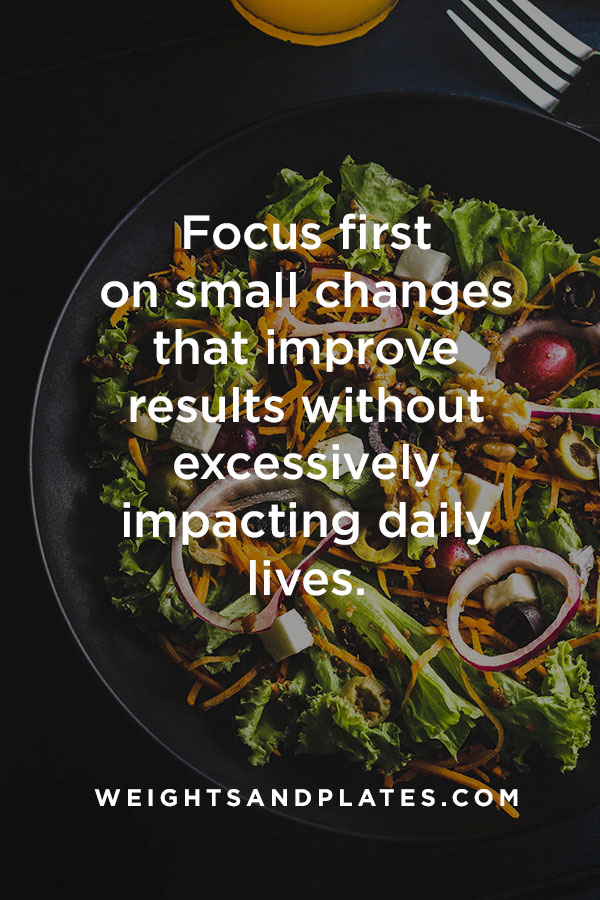After years of experimentation with various diet coaching methodologies, Robert observed that much of the available programs were far more complicated than necessary for the average nutrition client. Thus, he developed a step-by-step system to develop a basic foundation of habits, which he coined the Nutrition Linear Progression.

Your nutritional landscape, whether good or bad, comprises of: calories, macronutrients, meal timing, food quality, and supplements to name a few. Good nutrition means that you have balanced out these variables to meet your health and fitness goals. But, more likely than not, you are doing OK with some of these variables but need to work on others. This is true of most people, especially those who have taken other healthy steps, such as strength training.
Traditional Nutrition Coaching

Traditional nutrition coaching tries to optimize all these variables all at once. If you have ever tried to completely overhaul your eating habits, you know how overwhelming that can be. The common prescription to begin weighing and measuring your food and, suddenly, you are not only trying to break lifelong habits of eating, but you are also trying to add new and unfamiliar routines. It’s no wonder that 95% of diet efforts fail for non-compliance. The approach itself is flawed.
After years of observing patterns of behavior and listening to feedback from research and the market, it was easy to recognize that what has previously been done is not working. Therefore, rather than throwing a highly complicated diet at our clients, we have decided to break “the diet” up into individual habits that can be incrementally added over time, resulting in the development of an individualized plan, hence the name: The Nutrition Linear Progression.
Habits are your foundation
The Nutrition Linear Progression is a step-by-step guide to achieving healthy eating habits and, ultimately, a healthy lifestyle. Similar to incrementally adding weight to the bar, our team of Registered Dietitians will incrementally add habits to everyone’s nutrition toolbox, creating an individualized diet plan that clients can take with them for the rest of their lives.
With that in mind, the overarching intent of the program is to develop a pattern of eating to support strength training while managing body fat and take into account the following truths about eating: we go out to eat, fat is delicious, weighing and tracking may not be right for everybody all the time, and consistency is king.
The Nutrition Linear Progression takes into account the sometimes very challenging realities around food: that it is entwined with our habits, our emotions, and even our culture. We understand that making meaningful dietary changes is built upon consistency through ingraining habits. To do that, we will focus first on small changes that improve results without excessively impacting daily lives. Then we’ll move on to the next small change that will have the biggest impact, and so on. Step-by-step, habit-by-habit, our nutrition coaches will guide our clients through the process of changing their relationship with food.
For the first few days of the program, rather than self reporting your food intake, we use a Visual Food Diary to determine your baseline dietary intake. Before you eat, simply take out your phone and take a picture of your meal. This way our coaches can see what you are actually eating and determine which habit to begin working on. Once you receive your habit from your coach, rather than track your portion sizes by weighing and measuring your food, we’ll use a much simpler technique: quantifying portion sizes in relation to your own hand.
The Nutrition Linear Progression is comprised of a series of habits. These habits are addressed within each phase. We will address low-hanging fruit first (like excess soda/ or alcohol or skipping meals), then make sure protein and carbohydrate consumption are adequate to fuel your workouts and support training and recovery. Then we will finish off by moderating fat intake to manage body composition.
Making gradual changes will help you build momentum to carry you through the more challenging aspects of the program.

Consistency is Key

his is NOT a 12-week weight loss program. Consistency drives progress on all nutrition programs and pretty much anything in life. If you want to improve upon something consistent commitment to the necessary steps is essential. Success on the Nutrition Linear Progression is measured as 7 consecutive days of compliance for the assigned habit. Progress from one habit to another will only take place if the previous habit has been applied for 7 consecutive days. Some clients will successfully accomplish a habit in the first week it’s assigned, while for others it may take a few weeks to get consistent. If the client burns out on a habit and becomes mentally overwhelmed with the process, we prescribe a “reset” to a previous step that is much easier to complete and then move onto the next step with positivity and new ideas.
By the way, this approach works great for those not officially following the Weights & Plates Nutrition Linear Progression as well. As you try to build good habits and develop a right relationship with food, start with a single small habit (I.e. “Low hanging fruit”) that will make the biggest change towards your performance and aesthetic goals. Focus on that one change, until you are able to successfully accomplish it for 7 days straight, before moving on to the next habit. Doing this will result in better compliance, improved performance, and the development of a long-term, sustainable, healthy relationship with food, rather than the common crash diet-and-then-rebound characteristics of traditional diets in our culture.




